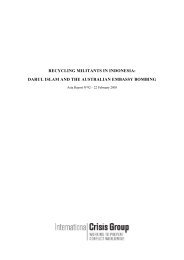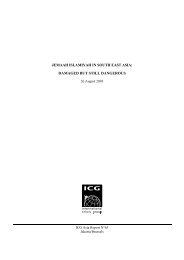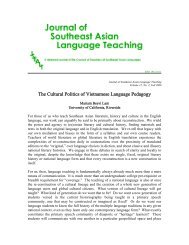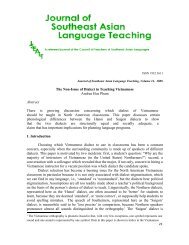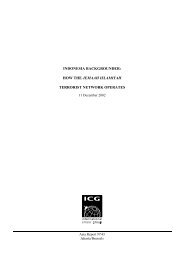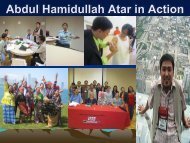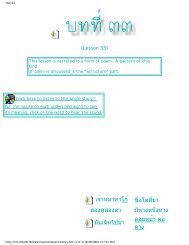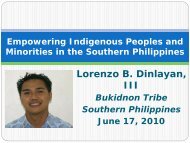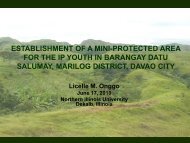Introduction - SEAsite - Northern Illinois University
Introduction - SEAsite - Northern Illinois University
Introduction - SEAsite - Northern Illinois University
You also want an ePaper? Increase the reach of your titles
YUMPU automatically turns print PDFs into web optimized ePapers that Google loves.
Prentation Abstracts<br />
Khampha Sidavong*, Ph.D.<br />
The Lao Language and Lao People<br />
Manchester, Connecticut<br />
According to the http://countrystudies.us/laos and Maha Sila Viravong’s documentation<br />
on the early history of Laos: In the seventh century, a northwesterly<br />
migration of Tais from their region of origin in northwestern Tonkin brought to the<br />
Ta-li region in what is present-day Yunnan, China, a successor state to the Ai Lao<br />
kingdom. This new kingdom, Nan-Chao, expanded its power by controlling major<br />
trading routes. Culturally, this polytechnic, hierarchical, and militarized state was<br />
to have a great influence on later societies in Indochina, transmitting the Tantric<br />
(Hindu Sansakrit, Pali) Buddhism of Bengal to Laos, Thailand, the Shan state,<br />
and possible Cambodia, the political ideology of the maharaja (protector of Buddhism).<br />
Both findings are similar to each other but no one yet can determine how<br />
our ancestors acquired the ability to speak.<br />
The linguistic origin of the Lao language is divided into two periods.<br />
1. The first Linguistic period have its roots in the Buddhism script which<br />
used the Pali and Sanskrit languages and originated in India about two thousand<br />
five hundred forty eight years and seven months ago (2,549 years since Buddha’s<br />
passing), during the reign of King Asoka Maharaza. The King reformed the Buddhism<br />
official doctrine and language. After the reform, the King appointed two<br />
monks: Phra Sona and Phra Outhara their task was to spread the Buddhism Doctrine<br />
throughout central and South East Asia which makes up the Laos territory in<br />
Nongsae and current Laos or Souvannaphom pateth.<br />
2. The second Lao Linguistic period have its origins in the Cambodian Buddhism<br />
which also used Pali and Sanskrit languages, during the reign of King Fagnum<br />
Maharaz who returned to Laos establishing the Lanexang kingdom in 1349.<br />
The Laotian Language Elite Committee of the Royal Lao Government from<br />
1953-1975 passed solution order # 10 to change the original 41 characters to 27<br />
and created new 6 compound characters.<br />
The current Lao PDR government reduced the original Lao alphabet from 27<br />
characters to 26 characters. The full report is included on the hand out.<br />
The first Lao Lanexang Kingdom Dictionary was written in June 7, 2004 and<br />
completed on December 31, 2004. This Dictionary will contain the meaning and<br />
root.<br />
President: New England Arch, Inc. and Sidavong and Associates<br />
Founder: “The Free International Economic Trade Zone” between border of Laos,<br />
Thailand and Cambodia namely “The Emerald Triangle Project”<br />
Kitirat Sihabun<br />
The Laos historiography in the Socialist State Period of the Lao<br />
People’s Democratic Republic<br />
Ph.D. Candidate , Mahasarakham <strong>University</strong>, Mahasarakham, Thailand<br />
The Lao People’s Revolutionary Party under Kaysone Pomvihan, the great<br />
leader of Laos, pursued the power struggle with the government in Vientiane, successfully<br />
ousting the government and establishing the new regime under the Lao<br />
People’s Revolutionary Party on 23, August, 1975.<br />
On the first of December, 1975, representatives of Lao people opened the<br />
grand meeting in Vientiane in which the throne abdication by the monarch, Sri<br />
Sawangwatana, was officially approved.<br />
Dissolution of the national ad hoc coalition government, official acceptance<br />
of the national flag, the national anthem and the formation of the Lao People’s<br />
Democratic Republic were formally declared and recognised. Chao Supanuvong<br />
was installed as the nation’s chair man. Kaysone Pomvihan was the prime minister<br />
of the new government. The incident above mentioned was the critical turning<br />
point in the Lao history. The administrative system under the monarchy which had<br />
been held for thousands of years came to an end.<br />
Laos after the 1975 Revolution with the Lao People’s Revolutionary Party as<br />
the supreme body saw many changes in politics, economy, society and culture. It<br />
also witnessed its history being rewritten.<br />
The present work deals with what content and concept the new Lao history<br />
wants to present. It also explores in what context the said history was written and<br />
for what purpose the history was made.<br />
Suksavang Simana<br />
The Chao Ai- Chao Noong Legend and Tradition<br />
Director and Co-Founder, “Association for Research Development”, Lao PDR<br />
This paper focuses on the tradition of ‘Chao Ai, - Chao Noong’ as it existed<br />
between the Phia Kasak as ‘Chao Ai’ (older Prince), and the King of Luang Prabang<br />
as the ‘Chao Noong’ (younger Prince), and sheds light on the ritual relationship<br />
that existed between them.<br />
The tradition of the two unequal Prince-brothers, based on a legend about<br />
two brothers, reflects the real life and social reality of the Kmhmu’ Kasak people<br />
as the older ones and the Lao as the younger ones.<br />
The Phia Kasak and the King both lived together in Luang Prabang in an<br />
unequal status relationship. The elder of the two princes was the slave and servant<br />
of the younger. Many people today are not familiar with the legend, the ritual, or<br />
its social background.<br />
The older of the two Prince-brothers, the Phia Kasak, had two ritual functions:<br />
1. to feed the spirits of the Meuang, (area) and 2. to send the fruit of longevity<br />
to the King as a blessing.<br />
As reward he earned just scoldings of the younger brother (the King) and<br />
would be chased away with a curse.<br />
The topic of Chao Ai, Chao Noong also touches on the unequal status of<br />
the indigenous Kmhmu’ in comparison with the Lao, which has existed in Laos in<br />
times past, with the Lao holding the power, and exploiting the Kmhmu’ population<br />
that was lacking rights and had no power.<br />
Ven. Phramaha Bounkong Singsouvanh<br />
How does Buddhism help the Community?<br />
President, Laotian-American Buddhist Monks Organization in America, Inc.,<br />
Hawaii<br />
The background of how Buddhism spread throughout South East Asia and<br />
North America Continent.<br />
What are the strategic areas to act in the process of making Buddhism widely<br />
known to the younger Lao-American generation?<br />
Religious movements aimed at the revitalization of society have helped<br />
people adapt to changing conditions. Religion establishes and maintains family<br />
and social control. It does this through a series of moral and ethical beliefs, along<br />
with real and imagined rewards and punishments, internalized in individuals.<br />
Djaja D. Soejarto*,**, Bounhong Southavong***, Kongmany<br />
Sydara***, Somsanith Bouamanivong***, Mary C. Riley*, Amey<br />
Libman*, Marian R. Kadushin**, Charlotte Gyllenhaal*<br />
A Collaborative Program Between the <strong>University</strong> of <strong>Illinois</strong> at<br />
Chicago and the Traditional Medicine Research Center of Laos<br />
in the Study of Lao Medical Plants<br />
<strong>Illinois</strong><br />
*Program for Collaborative Research in the Pharmaceutical Sciences (PCRPS),<br />
College of Pharmacy, <strong>University</strong> of <strong>Illinois</strong> at Chicago, 833 S. Wood St., Chicago,<br />
IL 60612 and **Department of Botany, Field Museum, 1400 S. Lake Shore Drive,<br />
Chicago, IL 60605, USA<br />
***Traditional Medicine Research Center, Ministry of Health, Vientiane, Lao<br />
People’s Democratic Republic<br />
In 1996, the <strong>University</strong> of <strong>Illinois</strong> at Chicago (UIC) initiated an informal<br />
scientific cooperation in the study of medicinal plants of Laos with the Traditional<br />
Medicine Research Center (TMRC), Vientiane. This cooperation was<br />
strengthened in 1998, when TMRC joined the UIC-based International Cooperative<br />
Biodiversity Group (ICBG) consortium to undertake “Studies on Biodiversity<br />
of Vietnam and Laos”. The ICBG is a program administered by the Fogarty<br />
International Center, through funds from the National Institutes of Health (NIH),<br />
the National Science Foundation (NSF), and the Foreign Agricultural Service of<br />
the United States Department of Agriculture (FAS USDA). The ICBG Program is<br />
an experiment by the US government in the implementation of the terms of the<br />
United Nations Convention on Biological Diversity (CBD), whereby researchers<br />
in developed countries collaborate in the studies of the biological diversity of<br />
biodiversity-rich countries, sharing the benefits in the process and, in the event of






